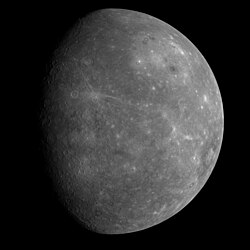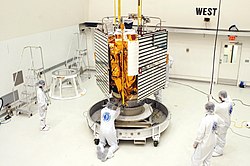MESSENGER - MDIS
Autor/Urheber:
NASA / JHU/APL
Größe:
250 x 241 Pixel (34355 Bytes)
Beschreibung:
"The multi-spectral MDIS has wide- and narrow-angle cameras (the “WAC” and “NAC,” respectively) – both based on charge-coupled devices (CCDs), similar to those found in digital cameras – to map the rugged landforms and spectral variations on Mercury’s surface in monochrome, color, and stereo. The imager pivots, giving it the ability to capture images from a wide area without having to re-point the spacecraft and allowing it to follow the stars and other optical navigation guides.
The wide-angle camera has a 10.5° by 10.5° field of view and can observe Mercury through 11 different filters and monochrome across the wavelength range 395 to 1,040 nanometers (visible through near-infrared light). Multi-spectral imaging will help scientists investigate the diversity of rock types that form Mercury’s surface. The narrow-angle camera can take black-and-white images at high resolution through its 1.5° by 1.5° field of view, allowing extremely detailed analysis of features as small as 18 meters (about 60 feet) across. "
Weitere Informationen zur Lizenz des Bildes finden Sie hier. Letzte Aktualisierung: Sat, 21 Jan 2023 05:25:24 GMT
Relevante Bilder
Relevante Artikel
MESSENGER
MESSENGER war eine NASA-Raumsonde des Discovery-Programms, die den sonnennächsten Planeten Merkur erforschte. Die Abkürzung ergibt das englische Wort für ‚Bote‘ und bezieht sich so auch auf den römischen Gott Mercurius, den Götterboten. Die Sonde startete am 3. August 2004. Auf ihrem Weg in den inneren Teil des Sonnensystems gab sie in mehreren Vorbeiflugmanövern an Erde, Venus und Merkur so viel Bewegungsenergie ab, dass sie am 18. März 2011 beim vierten Vorbeiflug am Merkur mit einem 15-minütigen Bremsmanöver in eine Umlaufbahn um den Planeten einschwenkte. Messenger war nach Mariner 10 die zweite Raumsonde, die den Merkur besuchte, und die erste, die ihn als Orbiter umrundete. Die Mission endete am 30. April 2015, als die Sonde nach Aufbrauchen des Treibstoffs auf Merkur einschlug.
.. weiterlesen













